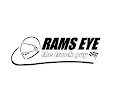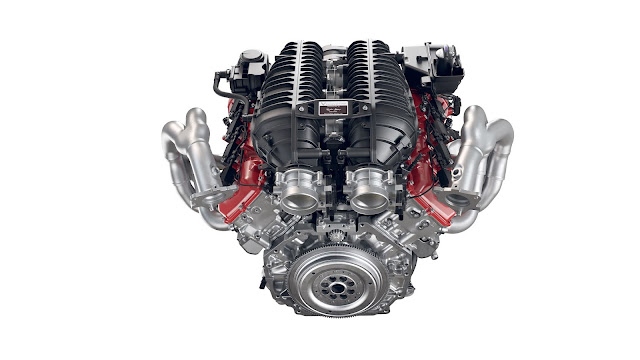Despite hearing and reading the rumours over and over again about the all-new, 5.5 litre, naturally aspirated high revving V8 Chevrolet was putting in the upcoming C8 Z06, I am still completely awe struck by what Chevrolet has done and sticking to a naturally aspirated V8 against all odds. Please take a moment to welcome the most powerful naturally aspirated production V8 the world has ever seen (at least mainstream production). The title previously belonged to the now dead SLS AMG, which had AMG's legendary 6.2 litre V8 making 622 hp and 468 lb-ft of torque. The New Z06 eclipses the horsepower figure with a whopping 670 hp at a scarcely believable 8,400 rpm (with an 8,600 rpm redline). Despite the high revving nature AND the smaller displacement (5.5 litre vs 6.2 litre for the Merc), torque hardly suffers with a healthy 460 lb-ft of torque, only 8 lower the the bigger displacement AMG engine.
At a time when AMG, BMW, and even Ferrari have abandoned naturally aspirated V8s, and after its own predecessor, the C7 Z06, abandoned the naturally aspirated 505 hp 7.0 litre LS7 in favour of the supercharged 650 hp 6.2 litre LT4, Chevrolet returns to form with an all new DOHC 5.5 litre, high revving, naturally aspirated V8 which I think sounds better even than current F1 cars. The engine also steals another title, the largest displacement V8 with a flat plane crank, a title previously held by the now also dead Mustang Shelby GT350 and its 5.2 litre Voodo V8 making a relatively tame 526 hp. If you aren't excited about this engine, at least appreciate the incredible engineering and passion behind the project that would have been needed to put it into production when even cross-town rival Ford has abandoned V8's all together in the Ford GT in favour of an Ecoboost V6 (Ford, are you listening?).
With that said, like that Ecoboost V6 which found its way in the Ford GT race cars and Daytona Prototypes, Chevrolet is claiming strong ties to its racing program. Chevrolet says a more restricted version of this engine is in the C8.R race car which captured six victories and seven pole positions, and set the fastest class race laps in six events during the 2020 IMSA season. In fact, the new engine shares nothing with its small block Chevy pushrod cousins (aside from the SBC engine family’s signature 4.4-inch bore spacing) and it is developed with help from race engine builder Pratt & Miller.
Chevrolet was adamant about not adding counter weights to the crankshaft to quell vibrations. Instead, it worked on minimizing the vibrations by reducing rotating mass using titanium connecting rods to achieve the same strength with less weight than forged steel and using an oversquare design with 4.10 in. bore and 3.15 in stroke to keep piston speeds down (among countless other design features, I'm sure, but those are the ones Chevrolet is bragging about). Of course, that doesn't eliminate all vibrations but what is left, Chevrolet said is in keeping with the mission of this car to be track focused so expect authentic vibrations to make their way into the cabin. Chevy didn't even make an effort to soften engine mounts to attenuate some of the vibrations.
The engine also features an all new DOHC cylinder head design with fully CNC-machined combustion chambers and intake ports, titanium intake and sodium filled exhaust valves, forged aluminum pistons and forged titanium connecting rods for low mass and high strength, and an all new active split intake manifold with twin 87 mm throttle bodies, shorty exhaust headers from the factory, and all new six stage dry sump oiling system with an 8-quart capacity. Output is SAE J1349 certified as expected now for all GM engines, with the aforementioned peak power of 670 hp arriving at 8,400 rpm, just 200 rpm before redline, and peak torque of 460 lb-ft arriving at a relatively lofty for a Chevy V8, 6,300 rpm but I would be willing to bet that this would not be even remotely an issue with the response this thing will have given the effort Chevy made in reducing rotating mass/inertia. Disappointingly but not unexpectedly, the engine will be backed solely by an 8-speed dual clutch transaxle, same as the standard C8, although the Z06 gets a shorter final drive axle ratio of 5.56
Now, although the engine is truly the star of the show, Chevy didn't cut any corners anywhere else. Every body panel is changed except for the doors, the roof, and the hatch, all for the sake of better aerodynamics, more downforce, more cooling, and the trademark wide body since the C6 Z06, with fenders growing by 30 (1.2 in.) mm in the front and 40 mm (1.6 in) in the back to make room for wider track and wider tires. The standard tires are Michelin Pilot Sport 4S measuring 275/30/20 in the front and a massive 345/25/21 in the back. Rear wheels are a massive 21x13".
The chassis is of course built on the architecture of the C8, which is largely unchanged unlike the C6 Z06 and ZR1. You can read more about the C8 design here. As is now traditional for Z06's, a Z07 package is available to bring a number of upgrades:
- Carbon fiber aero package with larger front splitter, front-corner dive planes, a rear wing and underbody strakes that are all made from carbon fibre and increase downforce to 365 lb. at 186 mph
- Upgraded FE7 suspension package with unique damper (magnetic) tuning
- Optional carbon fibre wheels saving 41 lb. compared to the standard forged wheels in the same size
- Brembo carbon ceramic brakes measuring 15.7 in. up front and and 15.4 in. in the back
- Michelin Cup 2 R tires (not just Cup 2's like the last Z06) that are bespoke designed for this Z06
Equipped with the Z07 package and optional carbon fibre wheels, Chevy claims a dry weight of 3,434 lb. and a 0-60 of only 2.6 seconds. But of course, that is only one small piece of the puzzle. The incredible traction this will have, combined with real downforce, huge mechanical grip, and 670 hp on tap, I have no doubt that this car will be a very serious performance car off the showroom floor. You can find full specs on the Chevrolet Media Site - 2023 Chevrolet Corvette Z06 and if you are at all a Chevrolet fan or Corvette fan, I strongly recommend you watch the 2023 Z06 Reveal video.
Pricing hasn't been announced and, while I have no doubt it will be the value of the century, I'm sure it will be significantly more than the C7 Z06 was. But at least you don't have to prove to Chevrolet that you are worthy of owning one like you did with the Ford GT... as much as I absolutely love the Ford GT, I think Chevy did a better job here for the average (ish) Joe. I can't wait to see one of these in the wild, or even better, on track!
Follow Rams Eye The Track Guy on Facebook and Instagram!


















Comments
Post a Comment